Many businesses organize events to raise brand awareness, promote new products/services, and build solid customer relationships. The pandemic caused an increase in online events, but with restrictions gradually ending, organizations have started to put hybrid and in-person events back on the agenda.
How can you ensure that your future event will turn into a “full house” success? One of the safest ways to achieve it is by introducing email marketing for events into your strategy. And since by 2023 the number of emails sent and received daily will reach 347.3 billion, using this accessible channel is a no-brainer to reach your audience and boost engagement.
This guide will show you how to create effective event email marketing campaigns to increase your registrations. Follow our tips to make these happenings worth remembering!
What Are The Benefits Of Email Marketing For Events?
So why should marketers utilize email campaigns to market their events successfully? Let’s see:
Increase Attendance
One of the most profound advantages of including emails in your event marketing strategy is increasing registrations and ticket sales. This is even more important if you aim to boost your ROI directly through those events.
You can initiate certain practices, such as adding an RSVP button or a referral program to benefit from word-of-mouth marketing. Moreover, many businesses offer incentives like early-bird discounts to indulge interested subscribers to attend.
Build Excitement
If you want to make subscribers look forward to your event, you can send small teasers with highlights to start nurturing them. For example, send a short video introducing keynote speakers or share photos from previous events.
However, you should use this email marketing tactic in moderation to avoid overwhelming your attendees and subscribers, especially if you’re simultaneously sending additional promotional emails for a different purpose. This could increase your spam rates and damage your brand reputation over time.
Share Information
Apart from sharing exciting content, having an email marketing strategy in place will also enable you to send confirmation emails and other valuable information to subscribers, including transactional emails triggered when they complete a specific action.
Therefore, these triggered emails will let you share more practical information, such as billing items, pre-event reminders, location, etc.
Nurture Your Audience
Finally, these email campaigns get into the bucket of your holistic marketing strategy, primarily if you’re operating in the SaaS industry where customer journeys are long and complex. These event campaigns can increase your leads and showcase your brand more.
Moreover, you can nurture subscribers who sign up for a specific event with relevant content to move them down the funnel. For instance, if someone subscribes to a webinar to learn more about a new feature but they’re not a customer yet, this is the perfect opportunity to convert them.
7 Email Marketing Best Practices For Events
If you’re a novice in this marketing territory, here’s how to build an effective event email marketing strategy that lets you host a successful event:
1. Pick An Email Marketing Platform
If you don’t already have an email marketing tool to streamline your campaign efforts, it’s time to do some research. Services like Moosend or Mailchimp check all the boxes you need to promote your next event like a pro. To find the perfect fit for your business, look for these features:
- Email templates and a drag-and-drop editor
- Marketing automation
- Audience management
- Flexible pricing and scalability
- High deliverability
- Mobile responsiveness
- Analytics and reporting tools
- A/B Testing
Read each product and pricing page to find which completes your existing marketing stack. It’s also wise to check their integrations to create a robust event email marketing process and boost your conversion rates.
You can gradually grow your email lists using signup forms on your website or beautiful landing pages. It’s mandatory to get the subscriber’s opt-in before mailing them to avoid receiving spam reports.
Are you looking for a new email platform? Read our comprehensive guide to discover some of the best tools in the market!
2. Design Beautiful Campaigns
To promote your event successfully via email, you should craft campaigns that are hard to forget. Log in to your email marketing platform, pick an event email template and customize it based on your branding needs.
For example, you can edit this dedicated Moosend template to showcase your brand to the world:
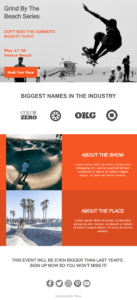
Add beautiful visuals, authentic GIFs, or short videos to make them more interactive. Ensure that the CTAs stand out from the rest of the text to boost registrations.
Finally, you can place your social media links at the email footer to nurture subscribers through the rest of your channels. An unsubscribe button is also a must to enable people to wish to opt out to do so.
3. Write An Intriguing Subject Line
One of the critical elements that can pivot your open rates is the email subject line. Practically, it’s the first email asset subscribers run into when they open their mailbox, and it should make a difference compared to the rest of the email messages we receive daily.
Overall, the subject line should reflect the email content and have an inviting tone to gain the subscriber’s attention. Many add a sense of urgency to activate the so-called FOMO (fear of missing out) to motivate readers to open the campaign faster.
Let’s see some event email subject lines to help you out:
- Breaking news! [Event name] is here!
- You’ll love to be here. Here’s your invite

- Final day to get your early-bird tickets
- Secure your spot now! VIP offer to [Event Name] ends today.
- Join the live show with [Influencer]
You can also add an emoji to make it more fun and use custom fields to add a personal essence to your campaign. We’ll explain more in the next section.
Not sure if your subject line is effective? Use our special testing tool – Refine and optimize your copy to boost open rates.
4. Send Personalized Campaigns
Personalized marketing should be at the core of every business’s marketing strategy, as consumers greatly value it. When receiving content relevant to their needs, they’ll feel more trust in your brand and take your messages more seriously.
Thus, you can start by adding the recipient’s name on the subject line and the email introduction using personalization tags or other features your platform offers. But it doesn’t stop there. The ultimate personalization tool for email marketers is email segmentation.
With segmentation, you can create distinct email list subgroups called segments, adding subscribers with shared characteristics. For example, you can send tailored content to VIP members with more incentives or send email versions to people who we’ve already attended some of your events and new subscribers.
In a nutshell, a successful segmentation approach will help you boost your click-through rates and event registrations. All you need is to understand your buyer personas in depth to deliver the best content version to them.
Here’s a personalized event invitation email from DocuSign:
Subject Line: Smiles Davis, you’re invited: Join us on Earth Day
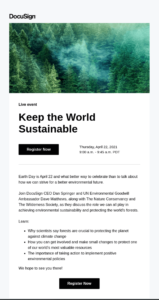
5. Schedule Automated Emails
If you’re an email marketing beginner, you’re probably wondering how much time and effort all these settings require. Thankfully, email automation platforms make these processes a piece of the cake.
Apart from transactional emails that require an SMTP server to work properly, you can set up automation workflows to save time from back and forths. For instance, when registration happens, you can automate a sequence with two emails on specific dates to nurture your audience before the event.
Here are the main benefits of email automation for your marketing results:
Many platforms like Moosend offer ready-made recipes to free your hands and enable you to find quick solutions for different types of automation you’d like to build, such as lead nurturing and behavior-tracking campaigns in simple steps.
6. Analyze Key Metrics
You can’t build an effective event email marketing strategy without keeping track of the most critical email metrics. Let’s see them:
- Οpen rates
- Click-through rates (CTR)
- Click-to-open rates
- Conversion rates
- Spam complaints
- Bounce rates
It’s essential to report on these metrics regularly to see what works and what needs to be improved over time. Keep a close eye on that data and combine them with info from additional platforms such as your CRM solution and Google analytics to reach safer conclusions.
Moreover, tools like click maps will help you design better campaigns and realize what patterns work best for your audience.
7. Test Your Campaigns
A/B Testing is a valuable marketing tool that helps you choose the more effective version of an email element and send it to most of your subscribers. This way, you understand more about their behavior and boost your email performance simultaneously.
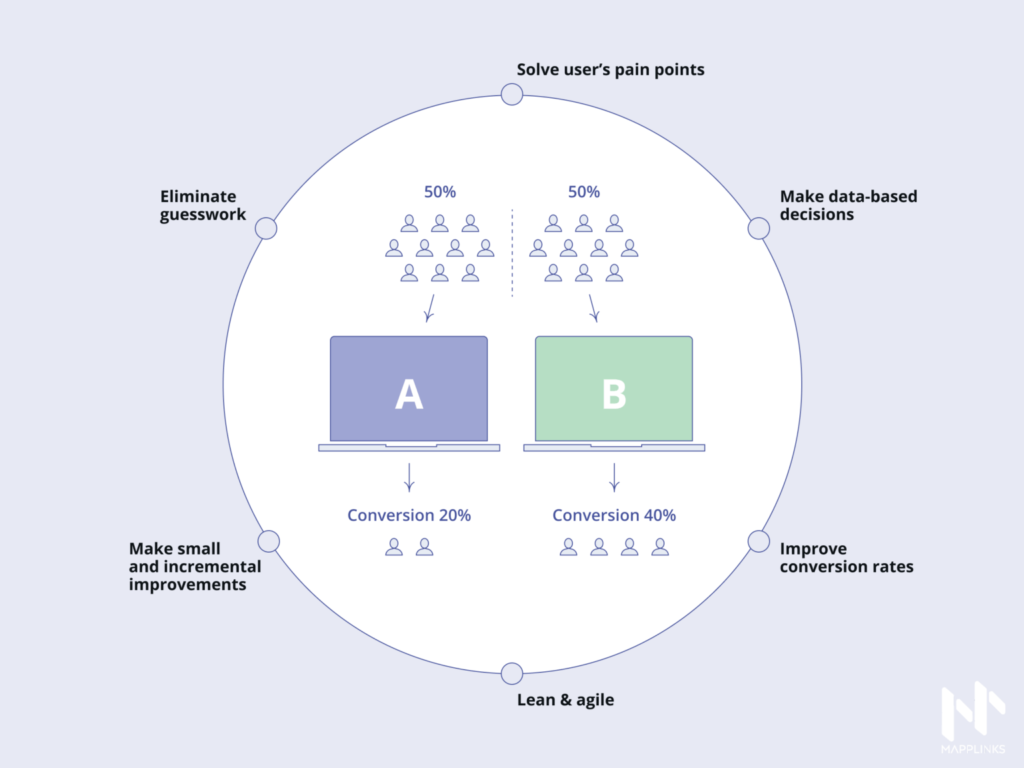
These tactics will help you learn more about your audience and what they expect from your brand and improve your promotional efforts over time. One of the most important elements to test is your subject line – experiment with different versions and see which one gets more attention for future reference.
Email Campaign Types For Event Promotion & Examples
Let’s see what email campaigns you can set up as part of your event planning to increase registrations:
1. Event Invitation
This is the first email campaign of this series, an announcement that has the main event details and a registration call-to-action (CTA) button. The subject line should be inviting to increase open rates and get subscribers genuinely interested in your event.
Finally, it’s wise to pay attention to the email design to attract the right audience. Add a visual or video that showcases your event vibes to show them what to expect. Check this example from Willo to get a better grasp:
Subject Line: You’re invited…
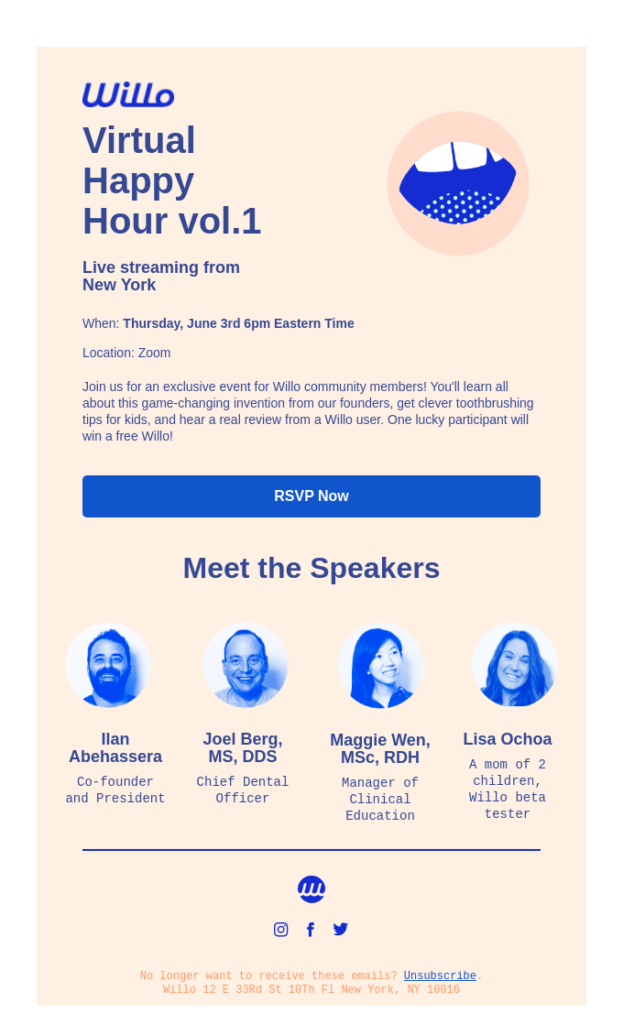
Need some inspiration to design a beautiful event invitation email? Read our comprehensive guide and get ready to shine.
2. Conversion-oriented campaign
If you want to boost your attendance and ensure a full-house event, you can also give some incentives to non-openers or people who have opened the first campaigns but skipped the registration. For example, you can offer them a discount for a limited time or extend the early-bird offer.
If you cannot give monetary incentives, create dedicated campaigns with additional content like testimonials or a brief description of the presenters, followed by the benefits they’ll reap if they join.
Here’s how Tough Mudder introduced their discount:
Subject Line: Unleash your adventure

3. Event Confirmation Campaign
Confirmation emails aim to reassure subscribers that an action they took has been completed. For instance, you should set up a transactional email for people who registered for the event and joined your email list to confirm their actions.
Plus, keep in mind that these triggered emails receive high open rates. You can make the most of this trend to showcase some other activities or products you’d like to promote on the spot.
Here’s an example from a Moosend webinar invitation:
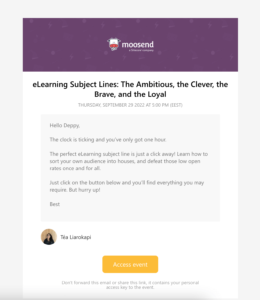
4. Pre-event Email Campaign
Do you want to give future attendees a sneak peek of their upcoming event? Then share a short video, visuals from previous events, or other elements that will make them look forward to it. You can also reveal more about your agenda to grow their enthusiasm.
In addition, it’s wise to set a reminder email with a countdown timer to nudge them a few days before the event. Considering how busy our lives are, this is essential for all event types. Here’s an example from one of the most notable brands – Apple:
Subject Line: Apple Worldwide Developers Conference 2022
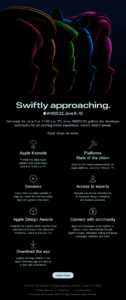
5. Post-event Email
Finally, you can create a follow-up email campaign to express gratitude to attendees and share the highlights from your event or recordings. You can also inform them about your upcoming activities if you believe that they’ll find them relevant.
If you want them to take a specific action after the event, mention it inside the campaign with the appropriate CTA to boost your conversion rates. Look at this fantastic email example from Maze:
Subject Line: Disco Conf ‘22 recordings are now available!
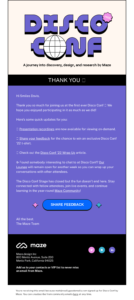
The Takeaways
In a nutshell, if you want to promote your next physical, online, or hybrid event like a pro, you should get email marketing in the game asap. Create different email campaigns to nurture your audience before the big day.
Overall, it’s an effective tool with outstanding outreach you can easily capitalize on over time. It’s easy to manage and gives marketers a creative territory to communicate with customers and prospects at a decent price.
Are you looking for a scalable email marketing solution with all the features needed to promote your events? Sign up for a Moosend account and experiment with our assets for free!
Email Marketing For Events FAQs
Before we finish this guide, we’ll give some quick answers to some of the most frequently asked questions regarding event email marketing:
1. What is email marketing for events?
It’s the process of promoting an event through emails to prospective attendees, including invitation, lead nurturing, and confirmation email campaigns.
2. How do you market an event through email?
Begin with an invitation email and continue with nurturing and informational emails, followed by a pre-event campaign to remind attendees or people you’d like to convert.
3. How many emails should you send before an event?
You can send five email campaign types: 1) Announcement, 2) confirmation, 3) lead nurturing, 4) teaser and 5) reminder email.
4. What is the best way to market an event?
Some suggestions include uploading it on social media, creating a dedicated landing page, building website signup forms, and sending relevant email campaign series.
The post Email Marketing For Events: Best Practices & Examples [2023] appeared first on Email Marketing Automation Platform for Thriving Businesses.
